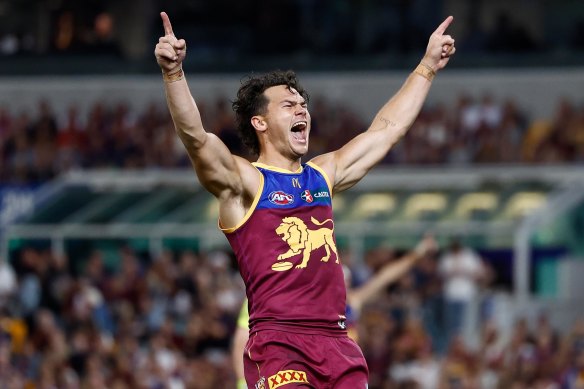Cam Rayner comes into Saturday’s semi-final against Greater Western Sydney with a point to prove.
The Brisbane Lions half-forward has had a career-best year. For the first time, he was picked in the All-Australian squad, even though he wasn’t selected in the final team.
Champion Data notes he has averaged career-highs for goals, disposals (15.5 a game), contested possessions, score assists (1.7 a game) and score involvements (5.6 a game).

Cam Rayner celebrates a goal during the Lions’ elimination final victory over Carlton last weekend.Credit: AFL Photos / Getty Images
Across the league, he’s one of 11 forwards to have averaged at least 15 possessions, a goal, an assist and five score involvements per year.
The query is whether he can reproduce his hot form across a finals series. And the deeper teams get into September, the going only gets tougher.
Rayner knows. Historically, he has been a good performer in the first week of finals.
In last year’s qualifying final against Port Adelaide, he was irresistible, kicking three goals in the first half on the way to a ruthless 48-point win.
But he failed to impact in the preliminary or grand finals, not winning enough ball forward of centre, where he does the most damage. He didn’t register an inside-50 in either match.
It wasn’t the first time. Against Geelong in the preliminary finals two years ago, Rayner was substituted off with an ankle injury. The Cats thrashed the Lions on the way to a premiership.
Against Carlton last week, he again scored three goals and was pivotal to setting up a 10-goal buffer that meant the Lions could get away with an error-strewn, unconvincing second half.
This time, Brisbane will have to travel, and Greater Western Sydney are unlikely to be so forgiving of even a poor quarter from an erratic Lions team.
It needs to be kept in mind that Rayner’s high half-forward role is one of the hardest to play, particularly as the intensity rises across a finals campaign. Hence his oft-alleged inconsistency.
Coach Chris Fagan has tried other ways to get Rayner more involved in games. Early in 2023, he was even trialled at halfback, before Keidean Coleman was settled in a play making role.
It didn’t suit Rayner, who quickly returned to the forward line, with Fagan admitting the experiment was a mistake.
In the midfield, Rayner has been used with more success, and he has again averaged a career-high in clearances this year (2.5 a game).
Against Melbourne in round five Rayner really shone on ball, winning an equal career-high 25 disposals, including nine game-breaking clearances.
It was a glimpse of the explosive, pack-busting player that Rayner was recruited to be when he was taken with the No. 1 draft pick in 2017.
So why not use him there more?
There have been queries about whether he has the endurance base for more midfield time. Rayner has slowly improved his tank, but even in that match against Melbourne, he did his best work in the first half, tailing away as the game wore on.
“He’s got better endurance now,” Chris Fagan told the club website at the start of the season. “He’s still not an endurance beast, but he’s worked on that enormously, enough to be able to play good minutes in the midfield, which is all that’s required.”
He has run out this season well: he’s ranked fifth among general forwards for scoreboard impact since the bye.
But the main reason Rayner doesn’t play more midfield minutes is competition. Rayner is sixth for centre-bounce involvements at the Lions, with just 6.4 a game: a pinch-hitting role.
When you see who is in front of Rayner, it makes sense. Lachie Neale (23.6 centre bounces a game) and Josh Dunkley (22.1) are locks for those inside roles.
After them is Hugh McCluggage, with 16 centre-bounce attendances. For Rayner to get more midfield time, McCluggage would have to be pushed back out to a wing.
Early in his career, McCluggage made his name as one of the best wingers in the game. But his vision and distribution makes him much more valuable to the Lions playing in the centre.
So, it’s only when at least one of these three players are resting that Rayner gets his chance to show what he can do at the coalface. After that, back to the forward line he goes.
And that’s the most high-pressure part of the ground – where expectations are greatest, where time and space are hardest to find, and where games are won and lost.
Rayner has had to deal with the pressure of expectation his whole career. If the Lions are to get past the Giants, he looms as their likely game-breaker. He is in the form of his life.